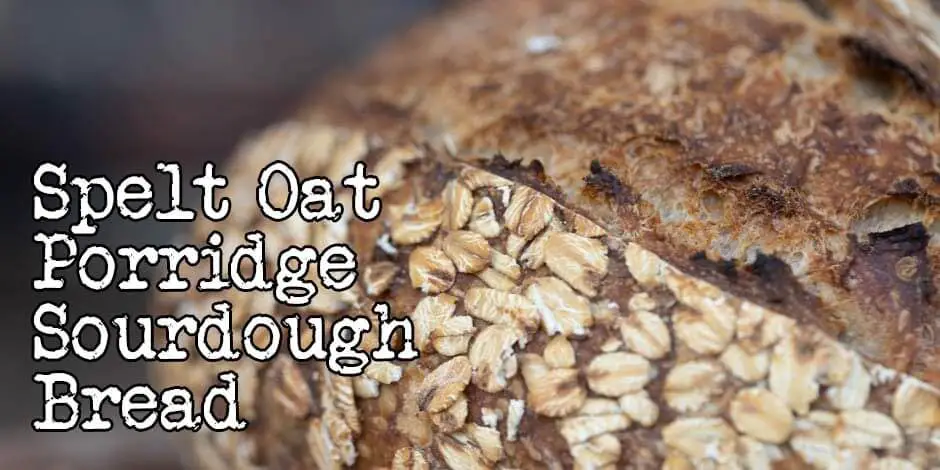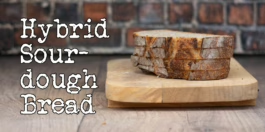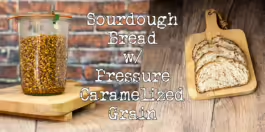Oatmeal is a wonderful thing to eat. It’s creamy, warm, and add cinnamon sugar and a good knob of butter on top and you’re golden. Did you know that it’s also wonderful if you put it into bread? This is my recipe for oatmeal sourdough bread.
Oatmeal bread is a very American thing. Porridge was a great way to fill the stomach before going out into the fields and if some of it was leftover it was an obvious choice to not throw it out, but to add it to your bread when baking the daily bread.
Did I mention it’s also delicious?
If you are just here for the recipe, you can press the button underneath to be automagically transported to the recipe:
Jump to RecipeThe dough in this oatmeal sourdough bread recipe
Vitals
| Total weight | 1416 grams |
| Pre-fermented flour | 8.3% |
| Hydration | 79.5% |
| Yield | 2 small loaves |

Dough
The dough is made from bread flour, which will give it its structure and oven spring, spelt for its amazing sweet and earthy notes.
A good amount of oatmeal (oat porridge) is mixed into the dough, which acts as a tangzhong. That means some of the moisture is trapped inside the oat grains and gives the bread a longer shelf life because the hydration is higher than it seems when you are working with the dough.
The amount of salt is a little higher than usual, but with a large amount of oatmeal added, the bread can become a little bland if it’s lower.
The hydration is 80% but will seem much lower. It all depends on the absorption of your flour, so if you know it can’t take a lot of water, you may want to lower the hydration slightly.
The inoculation is 20%, which is a good place to be for fermentation between 21°C-30°C (70°F-86°F).
| Weight | Ingredient | Baker's Percentage |
|---|---|---|
| 65g | rolled oats | 10% |
| 130g | water | 20% |
| Weight | Ingredient | Baker's Percentage |
|---|---|---|
| 450g | bread flour | 69.2% |
| 200g | spelt flour | 30.8% |
| 425g | water | 65.4% |
| 16g | salt | 2.5% |
| 130g | starter (100% hydration) | 20% |
As always, if you want to play around with the formula, change the quantity, hydration or inoculation you can do so here in my Bread Calculator.
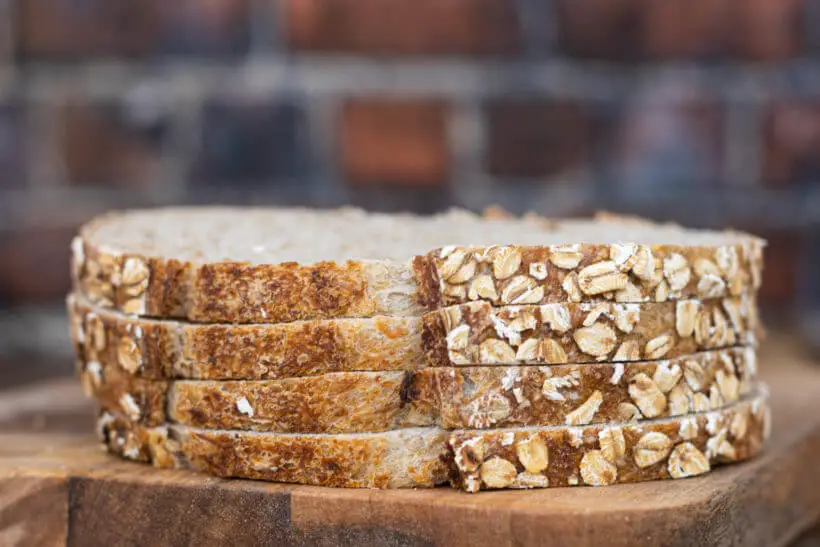
The conclusion of this oatmeal sourdough bread recipe
So this oatmeal bread is meant as a wonderfully moist daily bread. So does it deliver?
The combination of wheat, spelt and oats is a wonderful taste combination. The bread has a very nutty and somewhat earthy and sweet character.
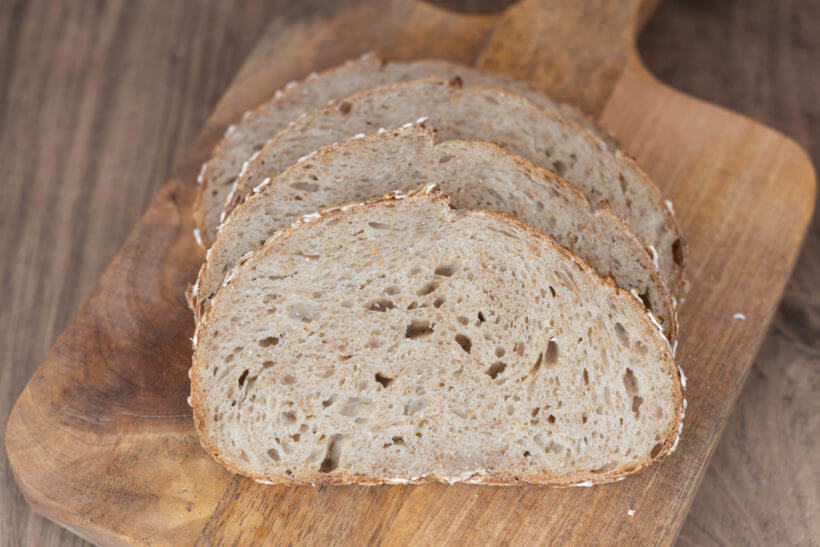
The crumb is closed, with many small air bubbles, which makes it perfect for sandwich application. The crust is crunchy, and the oats outside give in an interesting texture.
The crumb is also moist but in no way unpleasantly so. Best of all, this bread stays good for 3-4 days if kept the right way.
This could be your new daily bread if you only give it a chance.
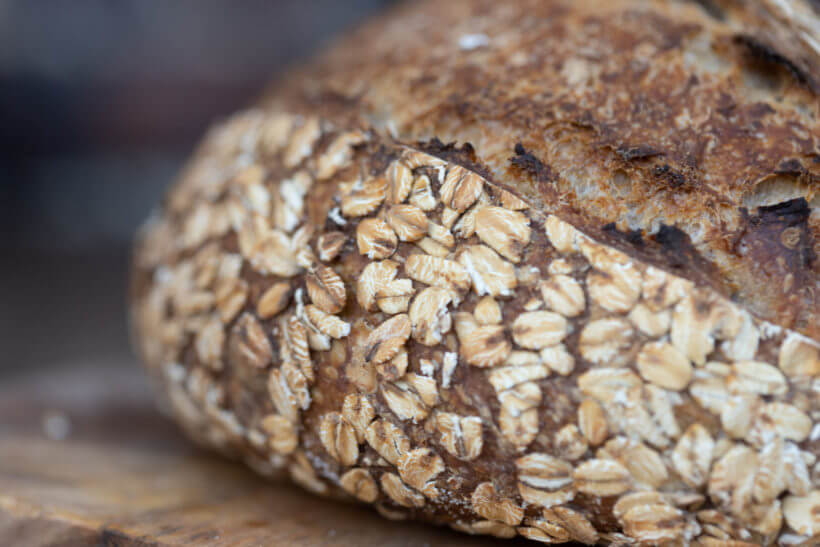
Please share this recipe for oatmeal sourdough bread on social media
This is my recipe for oatmeal sourdough bread. If you like the recipe, please consider sharing it with like-minded bread lovers on social media.
If you make it and post it on Instagram, please tag me as @foodgeek.dk so I can see it. That would make me very happy.

Oatmeal Sourdough Bread
Equipment
Ingredients
Oatmeal
- 65 g rolled oats
- 130 g water
Dough
- 450 g bread flour
- 200 g wholegrain spelt flour
- 425 g water divided
- 16 g salt
- 130 g sourdough starter fed and grown to its peak
Topping
- thick rolled oats, as needed
Instructions
Make the porridge
- In a microwave-safe container, add: 65g rolled oats and 130g water and give a quick mix.65 g rolled oats, 130 g water
- Microwave it on full until it bubbles. It took about 2 minutes in my 900W microwave.
- Then give it a good stir to make it cohesive. Put it away while it cools off.
- You can put it in the fridge or the freezer to speed up the process, but don't let it freeze solid.
Mix the dough
- To a medium bowl add: 450g bread flour, 200g whole grain spelt and 16g salt. Mix it to combine it.450 g bread flour, 200 g wholegrain spelt flour, 16 g salt
- Then add the cooled oatmeal. It’ll probably be clumpy, but you must break it up with your fingers so it doesn’t sit in clumps in the dough.
- Add 130g sourdough starter.130 g sourdough starter
- Add 350g water. That takes the bread to 70% hydration.425 g water
- If you feel like it can take more, you can add up to 75g more water, which will take the dough to 80% hydration.425 g water
- Mix it with your hands until all of the flour is hydrated. If the dough is stiff, you may want to knead it.
- Put it back in the bowl and let the dough rest for an hour. Then put it in a bulking container.
- Level the top of the dough, and mark where the top of the dough is. Then mark where it will have grown 50%.
- Then put it somewhere warm. I use my Brød & Taylor proofer set to 30°C/86°F.
Division and shaping
- When it’s grown, take the dough out of the container and split it in half. Then shape each dough piece into a loose ball using your bench scraper.
- Then let the dough balls rest on the counter for 20 minutes. When the 20 minutes are up, prepare a dishcloth with thick rolled oats.thick rolled oats, as needed
- Then it’s time to shape the dough. Watch the video to get a tutorial on how to shape the dough.
- To apply the oats, mist the top of the dough with a spray bottle. Then flip the shaped dough onto the oats.
- Roll it around to get the oats on the surface and put it in a proofing basket.
- If using boules, shape the sides to create more tension on the top of the dough. If using bâtards, do a quick stitch.
- Then put the dough in the fridge for at least 8 hours, up to 48 hours.
Bake the bread
- Heat your oven to 260°C/500°F for an hour. You should have a dutch oven inside the oven.
- When the oven is hot, grab your dough from the fridge. Don’t let it come up to temperature.
- Dust the bottom with rice flour to make sure it slides off the peel.
- Flip it onto the peel and score the dough using a lame.
- Grab the dough on the peel, and place the dough inside the bottom of the dutch oven. Turn your oven down to 230°C/450°F and bake for 20 minutes.
- Remove the top of the dutch oven and bake for another 25 minutes.
- Then take the bread out of the oven, and let it cool on a wire rack.
- To bake the other bread, put the top of the dutch oven back, reheat the oven to 260°C/500°F and bake the other bread as described above.



